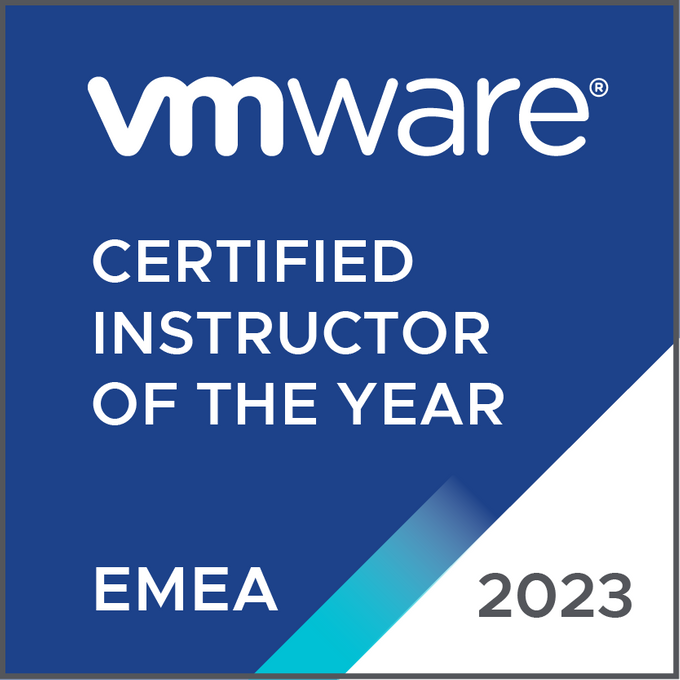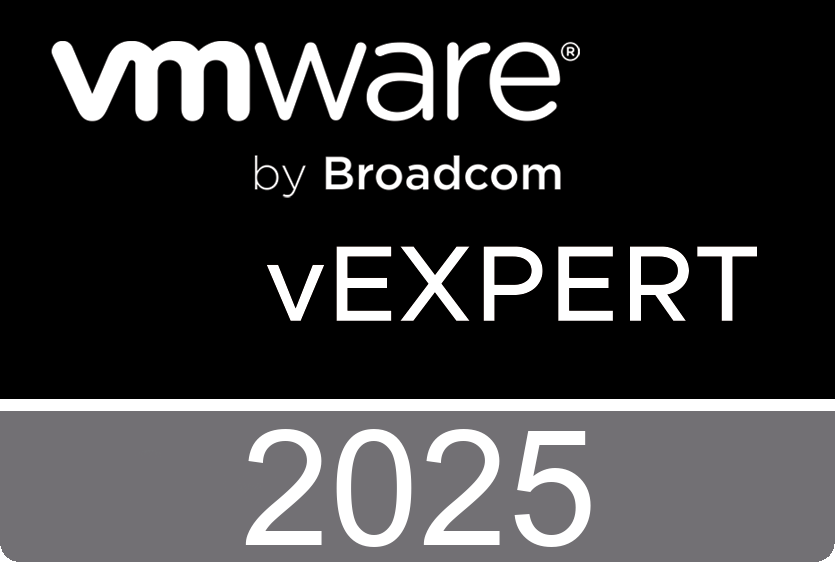VMware is working on a new training which will be released in the next months. It’s called VMware vCloud: Deploy and Manage the VMware Cloud. This course demonstrates to technical personnel how to deploy VMware vCloud for a public, private, or hybrid cloud environment and manage the on-going operation of the deployment. The course focuses on the private and public vCloud solutions but also includes information on how this approach supports a hybrid solution.The training course is still in beta but will most likely contain the following Course Objectives. After completing this course, you should understand the features and operation of vCloud and be able to do the following:
- Deploy VMware vCloud Director
- Manage vCloud Director to satisfy private, public and hybrid cloud business needs.
- Configure VMware vSphere storage to enable multiple tiers in provider virtual datacenters.
- Create vCloud Director organizations and vApps to satisfy business needs.
- Configure networking for organizations and vApps.
- Use linked clones to enable fast provisioning.
- Use VMware vCenter Chargeback to meter vCloud Director resources.
- Use VMware vCenter Operations Standard to monitor your environment.
Friday, October 28. 2011
Upcoming new training course - VMware vCloud: Deploy and Manage the VMware Cloud
Thursday, October 27. 2011
HP P4000 LeftHand SAN Solutions with VMware vSphere Best Practices
This white paper provides detailed information on how to integrate VMware vSphere 5.0 with HP P4000 LeftHand SAN Solutions. VMware vSphere is an industry leading virtualization platform and software cloud infrastructure enabling critical business applications to run with assurance and agility by virtualizing server resources. Complementing this technology, the HP P4000 LeftHand SANs address the storage demands and cost pressures associated with server virtualization, data growth, and business continuity.
P4000 SANs scale capacity and performance linearly without incurring downtime, enabling it to meet the requirements of small pay-as-you-grow customers to the mission-critical applications of an enterprise. This document presents configuration guidelines, best practices and answers to frequently asked questions that will help you accelerate a successful deployment of VMware vSphere 5.0 on HP P4000 SAN Solutions.
HP P4000 LeftHand SAN Solutions with VMware vSphere Best Practices
Juan's HP resources for VMware - http://jreypo.wordpress.com/hp-resources-for-vmware/
3PAR Utility Storage with VMware vSphere
This paper discusses the benefits of deploying VMware vSphere with HP 3PAR Utility Storage including: greater virtual machine (VM) density, simplifying administration, and realizing significant cost savings in virtualized server environments. The paper also includes best practices for an integrated VMware vSphere and HP 3PAR Utility Storage solution.
- Performance and reliability features
- Queue depth throttling
- Metadata locking with SCSI reservations
- vSphere Storage APIs – Array Integration (VAAI)
- Storage I/O Controls
- vSphere Storage APIs – Storage Awareness (VASA)
- VMFS versus RDM
3PAR Utility Storage with VMware vSphere
Wednesday, October 26. 2011
New Free Tool - Foglight Network Management System
Foglight Network Management System (NMS) is an enterprise ready network performance monitoring and configuration management solution. It installs in less than 15 minutes and auto-discovers key metrics for network resources, including hardware, operating systems, virtual infrastructure, databases, middleware, applications, and services allowing you to:
- Reduce the wasted time and chaos associated with sudden network issues
- Mitigate the risk of downtime
- Reduce mean-time-to-resolution of network incidents
- Provide admin and management level visibility
- Manage up to 100 network devices for FREE
- Download and install in only 15 MINUTES
Video - vCenter Infrastructure Navigator
vCenter Infrastructure Navigator automatically discovers application services, visualizes relationships and maps dependencies of applications on virtualized compute, storage and network resources. It's a component of the vCenter Operations Management Suite. vCenter Infrastructure Navigator enables application-aware management of infrastructure and operations to better understand the impact of change, provide more complete disaster recovery protection and minimize downtime.
- Automatically discover and keep up-to-date the names and version numbers of application components and services
- Visualize application relationships, communication paths and backend connections at the infrastructure, guest OS and application level
- Map dependencies of application components on the underlying virtual infrastructure to understand the impact of change and build disaster recovery plans with confidence.
![]()
The voice over of this video is done by Ben Scheerer, follow him on Titter via @benscheerer
Tuesday, October 25. 2011
VMware vSphere Client for iPad 1.2 offers two-finger vMotion
The VMware vSphere Client for iPad is a companion interface to the traditional vSphere client, optimized for viewing and managing your vSphere environment on the go. With this client you can monitor the performance of vSphere hosts and virtual machines. Virtual machines can be started, stopped and suspended. vSphere hosts can be rebooted or put into maintenance mode.
- Search for vSphere hosts and virtual machines in your vSphere environment
- Monitor the performance of vSphere hosts and virtual machines
- Manage virtual machines with the ability to start, stop and suspend
- View and restore your virtual machines’ snapshots
- Reboot vSphere hosts or put them into maintenance mode
- Diagnose vSphere hosts and virtual machines using built-in ping and traceroute tools
New in v1.2 is the option to migrate virtual machines without downtime using vMotion. The feature is available via Host & VM action menus. Virtual machines can also be two-finger flicked/dragged from the Host detail view to enter vMotion mode. Version 1.2 also offers:
- Ability to email vMotion validation error details to others
- View task progress reporting on VM cards
- Ability to refresh vCenter host list
- Support for ESX 3.5
- Support for VMware vSphere 5.0
Monday, October 24. 2011
VMware View for iPad 1.2 supports external display and AirPlay
VMware View Client for iPad makes it easy to access your Windows virtual desktop from your iPad with the best possible user experience on the Local Area Network (LAN) or across a Wide Area Network (WAN).
What's New in Version 1.2
- Optimized for VMware View 5 with improved performance
- Support for iOS 5 including AirPlay
- Presentation Mode for use with external display and AirPlay
- Embedded RSA soft token simplifies login to desktop
- Background tasking to move between Windows and iOS apps
- Updated look and feel
- Integrated online help
- Buffered text input for multibyte text entry
- Now in French, German, Japanese, Korean, Simplified Chinese
- Bug fixes
http://itunes.apple.com/us/app/vmware-view-for-ipad/id417993697


Saturday, October 22. 2011
Understanding VXLAN Virtual-Physical-Cloud L2/L3 Networks
VMware has announced VXLAN, the Virtual Distributed Layer-2 Network IETF draft standard, of which Arista is a co-author. VXLAN is a special encapsulation mechanism that runs between virtual switches and enables virtual machines to be deployed and moved on or between any server within the network. The main benefits to the IT department in planning to support VXLAN is the ability to deploy a virtual machine on any server within the network, regardless of its IP subnet. This enables the IT department to create a scalable network architecture that supports capacity on demand and workload mobility regardless of geography and IP addressing. VXLAN requires no changes to the underlying IP addressing architecture and should require no major changes to installed infrastructure in the data center.
What is VXLAN?
Virtual eXtensible LAN is a new network encapsulation and segmentation mechanism that enables a VM to be deployed on any server, regardless of the IP subnet the physical ESX host is in. It accomplishes this by encapsulating the MAC and IP packets from the virtual NIC with a UDP header and then using IP multicast to emulate a broadcast domain. To get traffic in and out of this encapsulated 'virtual wire' the non-encapsulated traffic must go through a vShield Edge virtual machine acting as a VXLAN gateway. Performing these elegant L3-transparent migrations with L2-only storage transport technologies like FCoE is impossible.
http://www.aristanetworks.com/media/system/pdf/TechBulletins/VXLAN_Overview.pdf
I invite you to take a look at the 'Fall 2011 Arista Webinar Series' that kicks off at the end of September. Arista will be joined by top industry partners to reveal the best practices of data centers, one vertical at a time. Arista Tech Education - For Engineers, By Engineers.
Friday, October 21. 2011
Spectaculair Opening Video VMworld 2011
This video was shown right before the Tuesday afternoon keynote at the VMworld 2011 in Copenhagen. I was searching for a few words to describe what I was feeling when I saw the opening video but I couldn’t find a good catch. Just take a look at the impression I shot and believe me when you were one of the attendees at this keynote you could hear a lot of wows left and right.
Thursday, October 20. 2011
Stand off with the Dutch vMafia
We've been hearing a lot about the Dutch vMafia, so we went to meet them to see if we could find out a little bit more about what they do. See if we managed to get away in one piece.







